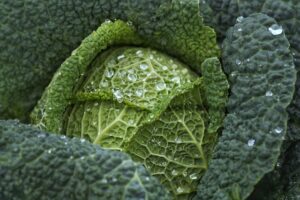Learn how to grow savory cabbage with this comprehensive guide. Covers key differences from other cabbages, planting tips, growing requirements, time to maturity (80-90 days), spacing (18-24 inches), pest management, and harvesting. Ideal for gardeners looking to cultivate this unique, crinkled-leaf cabbage variety.
Introduction to Savoy Cabbage
In the world of leafy greens, savoy cabbage stands out with its luxurious, crinkled leaves and delightful taste. If you’re a gardener eager to diversify your crops, an organic food enthusiast focused on sustainable practices, or a home cook looking for new culinary adventures, this guide is for you. We’ll explore everything from planting to pest control, ensuring your garden flourishes with this unique and rewarding vegetable.
Savoy cabbage, also known as curly cabbage, is a unique member of the cabbage family. Unlike traditional cabbage, savoy boasts crinkled, dark green leaves that are both visually stunning and delightful in texture. Known for its tender, delicate nature, this cabbage variety offers a milder, sweeter taste that pairs well with various dishes. Its versatility makes it a favorite among gardeners and chefs alike.
Differences from Other Cabbages
One look at savoy cabbage, and you’ll notice its distinct appearance sets it apart from other cabbages. The crinkled, bumpy leaves create a looser head structure, offering a texture that’s more tender and less dense. This characteristic gives savoy cabbage an edge in culinary applications, providing a milder, sweeter taste.
But appearance and flavor aren’t the only differences. Savoy cabbage is more cold-tolerant than many of its relatives, making it a hardy choice for gardeners in cooler climates. This resilience allows for a longer growing season, even as temperatures drop.
Growing Savoy Cabbage
Planting Savoy Cabbage
To get started on your savoy cabbage-growing adventure, it’s best to begin indoors. Sow seeds 4-6 weeks before the last frost, providing them a head start. Once seedlings have developed 4-6 true leaves, it’s time to transplant them outdoors. For those in cooler climates, direct seeding is also an option.
Optimal Soil Requirements
Savoy cabbage thrives in well-draining, fertile soil with a pH between 6.0 and 6.8. Incorporate rich organic matter to enhance the soil’s structure and nutrient content, offering your plants the best start possible.
Ideal Sun Exposure
Choose a planting location that receives full sun, ideally 6-8 hours daily. This ensures your savoy cabbage receives the energy it needs for robust growth.
Spacing for Healthy Growth
Proper spacing is crucial for healthy cabbage development. Plant seedlings 18-24 inches apart, with rows spaced 24-36 inches apart. This allows for ample air circulation, reducing the risk of disease and promoting strong growth.
Watering Savoy Cabbage
Consistent moisture is key, aiming for about 1-1.5 inches of water per week. However, avoid overhead watering to prevent diseases like cabbage rot. Instead, water at the base to keep foliage dry and healthy.
Fertilization for Robust Growth
Support your savoy cabbage with balanced fertilization. About 3-4 weeks after transplanting, side-dress with a nitrogen-rich fertilizer. Another feeding six weeks later ensures continued healthy leaf growth.
Time to Maturity
Patience is a virtue when growing savoy cabbage. From transplanting, expect a maturity period of 80-90 days. For direct-seeded crops, prepare for a slightly longer wait of 100-110 days. The reward is well worth it—firm, flavorful heads ready for harvest.
Pest and Disease Management
Savoy cabbage, like all plants, faces threats from pests and diseases. Common pests include cabbage worms, aphids, and flea beetles, each eager to munch on your hard work. Diseases like club root and black rot can also pose challenges.
Prevention methods are your best defense. Rotate crops annually to disrupt pest and disease cycles. Companion planting with herbs like dill and mint can deter pests naturally. Row covers provide physical protection, keeping unwanted visitors at bay.
Harvesting Savoy Cabbage
When your savoy cabbage heads are firm and fully developed, it’s time to harvest. Use a sharp knife to cut at the base, leaving a few outer leaves to protect new growth. Savoy cabbage can withstand light frost, which may even enhance its flavor. Enjoy the fruits of your labor in salads, stir-fries, or roasted dishes.
Tips for Success
To enjoy a continuous harvest, practice succession planting. Stagger plantings to ensure a steady supply of fresh savoy cabbage throughout the growing season. Use mulch to retain soil moisture, suppress weeds, and regulate temperature, creating an optimal environment for growth.
In windy areas, support developing heads with stakes or cages, preventing damage and ensuring a successful harvest.
Conclusion
Growing savoy cabbage is a rewarding endeavor for gardeners of all levels. Its unique appearance, delightful flavor, and cold hardiness make it a standout addition to any garden. By following these guidelines, you’ll cultivate a healthy, bountiful crop that complements your commitment to organic gardening.
Whether you’re savoring a home-cooked meal or sharing the bounty with friends, savoy cabbage offers endless culinary possibilities. For those ready to take their gardening skills to the next level, consider exploring companion planting or experimenting with new recipes that feature this versatile vegetable. Happy growing!

